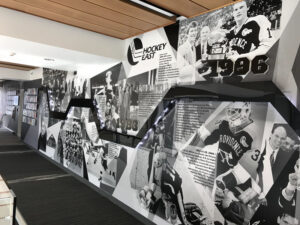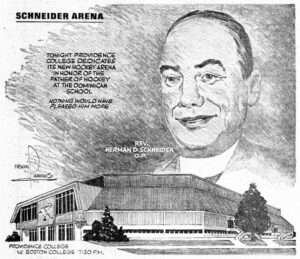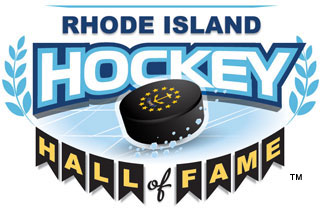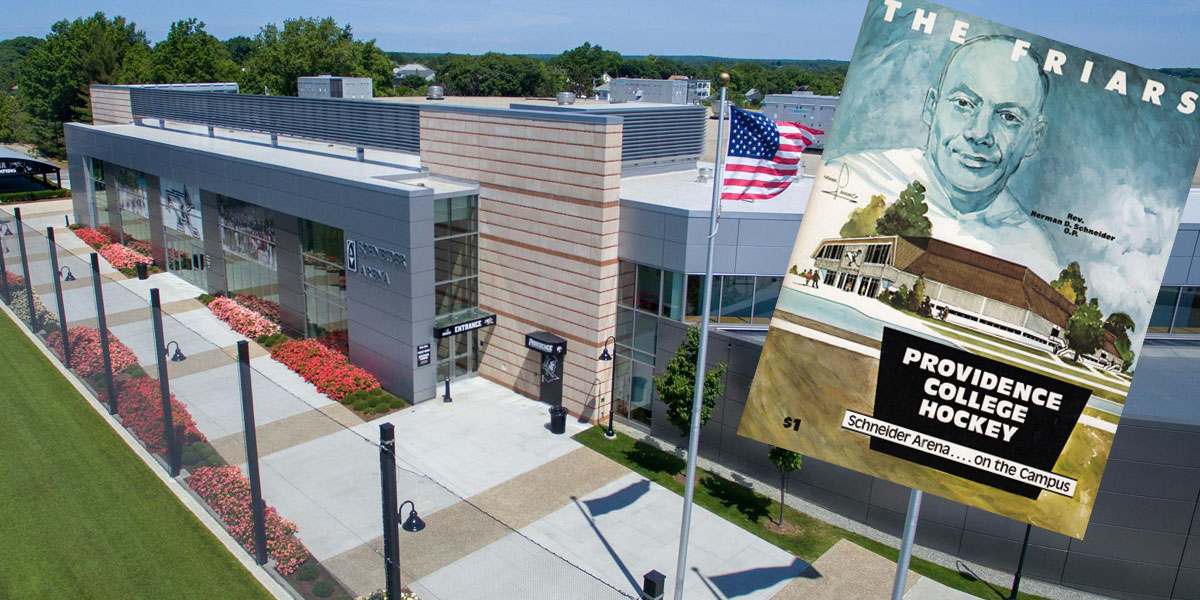 November 24, 1973, is a landmark date in the annals of Providence College hockey history. On that evening, the puck dropped for the first time at center ice, as Schneider Arena held its grand opening 54 weeks after groundbreaking. The star of the night was sophomore Dan Kennedy, a left winger from Montreal, who scored the first and only goal of the game to propel the Friars to 1-0 win over the University of Pennsylvania before 1,800 attendees.
November 24, 1973, is a landmark date in the annals of Providence College hockey history. On that evening, the puck dropped for the first time at center ice, as Schneider Arena held its grand opening 54 weeks after groundbreaking. The star of the night was sophomore Dan Kennedy, a left winger from Montreal, who scored the first and only goal of the game to propel the Friars to 1-0 win over the University of Pennsylvania before 1,800 attendees.
Now, 50 years later, the facility has been home to the Friars’ men and women’s hockey teams and host to international hockey camps, local interscholastic contests, public skating, figure skating exhibitions, junior hockey finals, and the Rhode Island Reds’ Calder Cup playoff series against Springfield in the spring of 1974.
 The arena is named in honor of the Rev. Herman D. Schneider, O.P., who is credited with championing the rebirth of varsity hockey at Providence College.
The arena is named in honor of the Rev. Herman D. Schneider, O.P., who is credited with championing the rebirth of varsity hockey at Providence College.
He graduated from P.C. in 1930, was ordained to the priesthood in 1935, and later served as a Navy chaplain with the 1st and 6th Marine divisions during World War II. During that time, he was tagged with the nickname “Dutch”, which his Dominican peers came to call him. The moniker was given to Father Schneider by baseball Hall of Famer, Gil Hodges of the Brooklyn Dodgers, who was in the same outfit in the Pacific.
After the war, Father Schneider was assigned to the St. Pius V parish across the street from the PC campus. He would later join his alma mater’s language department to teach German and eventually take on the role of assistant athletic director. In 1951, with the assistance of incoming freshman Ray Farrell, Tom Army, RI Reds and RI Auditorium owner, Lou Pieri, and a host of former local former high school hockey stars already enrolled in the college, he assembled a club squad and enrolled his skaters in the newly formed R.I. Amateur Hockey League. They flourished. Looking to advance the Friars’ hockey future, he cobbled together an intercollegiate hockey schedule in 1952 and Providence College officially suited up its first varsity team in 26 years.
The lack of its own ice rink became quickly apparent for the team. Given the paucity of available ice time in Rhode Island in the 1950s and the escalating popularity of ice hockey in the 1960s, the Friars had to juggle classes with irregularly scheduled practice times, sometimes at 3 a.m. or 5 a.m. Father Schneider provided round-trip rides for his players. When he wasn’t the taxi driver, he helped secure equipment and filled in for head coach Dick Rondeau when he was unavailable due to his full-time job.
The void became a crusade for Father Schneider. Beginning in 1953, “The Duke”, as his players called him, annually proposed plans to build a hockey facility, always accompanied with details on how to finance the endeavor. Despite his tireless efforts, the Friars continued to play their home games at the R.I. Auditorium for the next 20 years and until the old arena on North Main Street closed in the spring of 1972. The following season, the Friars traveled across town to Brown University’s Meehan Auditorium for home games.
 That same year, Friars’ head hockey coach Lou Lamoriello, members of the Mal Brown Club (which Father Schneider founded as the local chapter of the Providence College Alumni Association), and friends of Father Schneider organized the Ice Rink Feasibility Committee. The group approached the Providence College Corp. on a plan for an ice rink, which would be funded, in part, from income generated by renting ice time. The corporation gave its approval, and on November 9, 1972, Lamoriello, athletic director Dave Gavitt, and other dignitaries broke ground to begin construction on an arena at the corner of Admiral Street and Huxley Avenue. One year later, the Friars took the ice for their first game in their new home. But there was a hitch.
That same year, Friars’ head hockey coach Lou Lamoriello, members of the Mal Brown Club (which Father Schneider founded as the local chapter of the Providence College Alumni Association), and friends of Father Schneider organized the Ice Rink Feasibility Committee. The group approached the Providence College Corp. on a plan for an ice rink, which would be funded, in part, from income generated by renting ice time. The corporation gave its approval, and on November 9, 1972, Lamoriello, athletic director Dave Gavitt, and other dignitaries broke ground to begin construction on an arena at the corner of Admiral Street and Huxley Avenue. One year later, the Friars took the ice for their first game in their new home. But there was a hitch.
Built at a cost of $1.8 million, Schneider Arena had to be self-sufficient. Fortunately, Friar succeses on the ice were exceptional during the team’s first decade plus in the building and receipts from attendance and concessions were steady and strong. However, it was up to the Arena’s management, Lou Lamoriello and his lifelong friend and assistant in all things, Bob Bellemore, to generate the extra revenue required to pay the mortgage and cover on-going expenses beyond the rental of ice time. This need led to the birth of the popular Lamoriello Hockey Clinics, which ran for years and featured the teaching talents of some of the Friars’ most accomplished alumni. Skate sharpening, a hockey pro shop, and public skating sessions all contributed to the steady stream of income that paid the Schneider freight and kept the arena humming and building financial momentum.

Since its grand opening, Schneider Arena has undergone considerable upgrades, which have kept it one of New England’s most modern and popular hockey venues.
 An anonymous donation of $340,000 in 2006 helped kick off the first in a series of renovations that included improvements to the “Friends of Friars”, training, and locker rooms, as well as replacing the original red and yellow spectator seats to black and white to match the school’s colors. New office space and concession areas were also created. In 2013, the arena, which has a seating capacity of 3,030, underwent a multimillion-dollar transformation into a high-tech showcase with a 30,000 sq. ft. addition for enhanced fan comfort and luxury boxes, a state-of-the-art digital scoreboard and stereo sound system, and improvements to locker rooms.
An anonymous donation of $340,000 in 2006 helped kick off the first in a series of renovations that included improvements to the “Friends of Friars”, training, and locker rooms, as well as replacing the original red and yellow spectator seats to black and white to match the school’s colors. New office space and concession areas were also created. In 2013, the arena, which has a seating capacity of 3,030, underwent a multimillion-dollar transformation into a high-tech showcase with a 30,000 sq. ft. addition for enhanced fan comfort and luxury boxes, a state-of-the-art digital scoreboard and stereo sound system, and improvements to locker rooms.
 Schneider Arena has also become a shrine to honor the success and proud history of Friars’ men’s and women’s hockey, which includes an NCAA championship, Hockey East and Eastern College Athletic Conference (ECAC) titles, and the heroics and achievements of its players who set team and league records, had their names engraved on the Stanley Cup, represented their nation in the OIympics and IIHF World Tournaments, and have excelled in executive positions at the highest levels of the game.
Schneider Arena has also become a shrine to honor the success and proud history of Friars’ men’s and women’s hockey, which includes an NCAA championship, Hockey East and Eastern College Athletic Conference (ECAC) titles, and the heroics and achievements of its players who set team and league records, had their names engraved on the Stanley Cup, represented their nation in the OIympics and IIHF World Tournaments, and have excelled in executive positions at the highest levels of the game.
 Sadly, Father Schneider did not see his dream become a reality. He passed away suddenly on December 28, 1963, at his mother’s home in Long Island while on Christmas vacation. Only two nights before, he had been at Madison Square Garden cheering for the Friars’ basketball team.
Sadly, Father Schneider did not see his dream become a reality. He passed away suddenly on December 28, 1963, at his mother’s home in Long Island while on Christmas vacation. Only two nights before, he had been at Madison Square Garden cheering for the Friars’ basketball team.
On the date of this golden anniversary, Providence College can proudly reflect on the realization of “Dutch’s Dream” and its profound and long-lasting effect on the Providence College and Rhode Island hockey communities.
By Wayne Forrest


